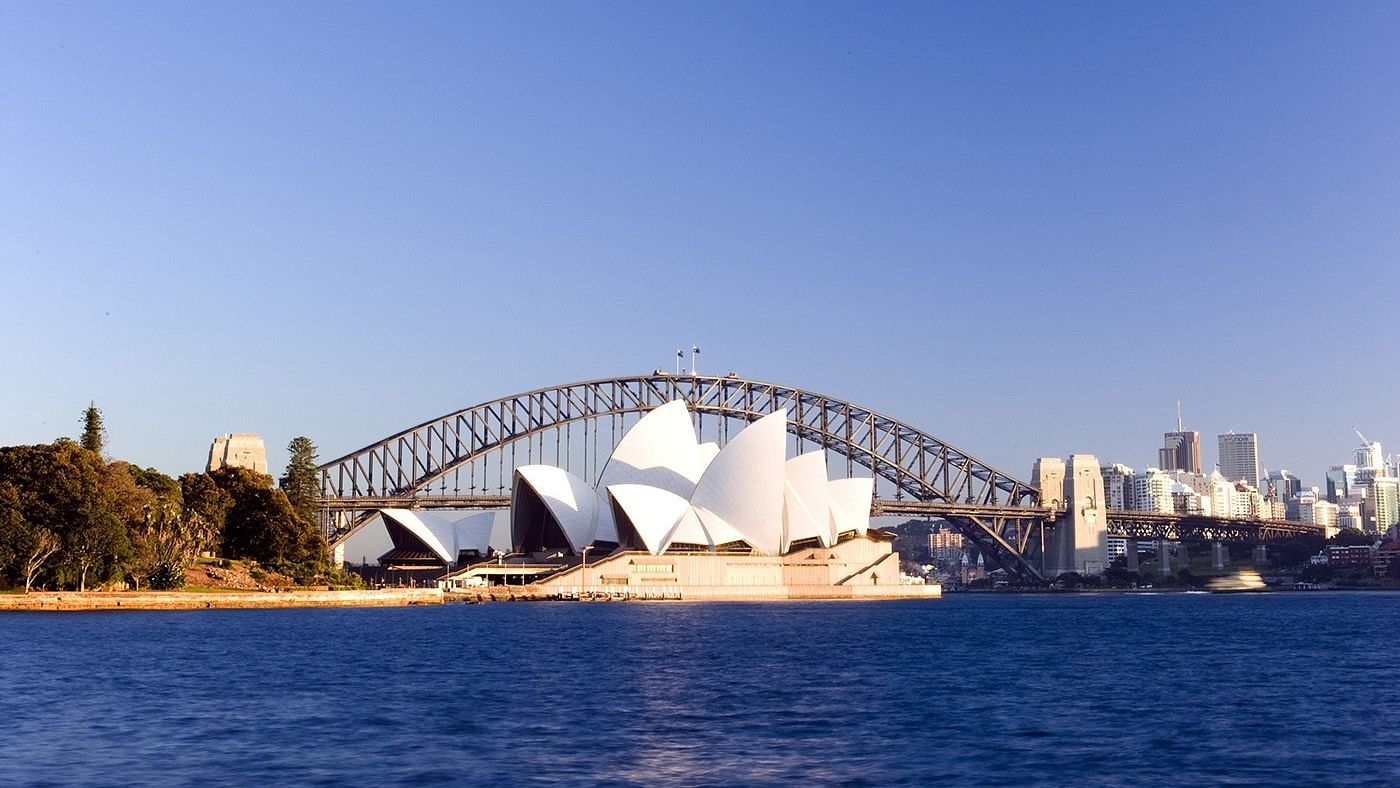
Sydney Opera House and the Harbour Bridge as seen from Lady Macquarie’s chair.
Credit: Kiran Mehta
At first glance, Sydney’s Opera House seems surreal. The curiously shaped structure — that defies engineering — has managed to take a concrete shape. The stories surrounding the house are just as delightfully nebulous. There’s drama and intrigue in its past. There’s fact and fiction, and sometimes the lines blur. Nothing is quite what it seems in this House.
Even though the Opera House turns 50 this October, her story dates back several centuries. After all, the Opera House sits on an ancient aboriginal site known as ‘Tubowgule’. As I walk towards the Opera House, I’m greeted by the sound of the didgeridoo, a musical wind instrument that’s an unofficial symbol of the indigenous culture of Australia. I strike up a conversation with the musician, Mick, who belongs to the Eora Nation. A crash course in ancient history follows: I learned that the indigenous people were the first settlers of Australia, making the continent their home much before European conquerors. Even today, Australia remains home
to innumerable indigenous groups that speak varied languages, and have different belief systems and customs. The Sydney metropolitan area alone is home to 29 different clan groups. These 29 groups are collectively referred to as the Eora Nation. Pronounced ‘yura’, Eora means ‘here’ or ‘from this place’. One among the Eora Nation, are the Gadigal. It is the Gadigal who owned ‘Tubowgule’. Today, the land on which the house stands is referred to as ‘Bennelong Point’, named after Woollarawarre Bennelong, a member of the indigenous community who was kidnapped by the British, and eventually became an interlocutor between the British colonists and the Eora Nation. Some historians describe him as a traitor, others dub him as a peacemaker and diplomat. The history of Australia is rich and complex. Perhaps no structure captures this aspect better than the Opera House, whose iconic roof is created from a web of 14 separate panels. Each is separate, yet part of a whole, sort of like a clan group; holding on to their own, while supporting the other. The result — a creation that’s absolutely fabulous.
The Sydney Opera House is open to many interpretations, much like the one above.
A meme that went viral a few years ago, offered a belly laugh: the house was alleged to have been inspired by a bunch of washed dishes, sitting on a rack, that serendipitously took the shape of the House.
However, the muse for Jorn Utzon — the famed architect behind the Opera House — was nature. But what particular aspect of nature inspired the roof, remains a mystery.
The geometry of sea shells, the wings of a bird, and the effect of wind on the sails of a ship are the most popular guesses.
The back story also remains shrouded in mystery: Utzon’s involvement in the House came about as a result of a design competition.
In 1956, the New South Wales government announced a competition where applicants were to send in designs for a national opera house. After scanning over 200 entries, Danish architect Jorn Utzon was announced the winner. His ambitious project would eventually take 14 years to complete, largely due to the roof, which looked good on paper but was almost impossible to execute. How could concrete take this shape? What would it be supported by?
Eventually, Utzon solved the puzzle that is the roof. He supposedly had a eureka moment as he enjoyed an orange over breakfast, one segment at a time.
Each panel of the roof (or each ‘shell’) is a precast concrete segment, held together by tensioned steel cables. If all these panels were taken down and fused together you’d get a gigantic sphere or a larger-than-life orange.
Other sources credit a grapefruit and famed Finnish-American architect Eero Saarinen, who was a judge on the panel of the competition. It’s unclear where (and with which fruit), the credit lies.
An estimated cost of 7 million AUD soon began to fall short. The Opera House would eventually cost a whopping 102 million AUD to come to life.
While Utzon completed a chunk of the exteriors, he didn’t see the project through to the end. A change of hand in the New South Wales government questioned budgets and time lines. So, Utzon resigned. An Australian architect, Peter Hall, was appointed in 1966 to complete it. Hall’s work is seen largely in the interiors.
The Opera House was inaugurated on October 20, 1973. Utzon never saw the completed piece. He had long since left Sydney, in a huff, never to return. He passed away in 2008, at the age of 90, without seeing his magnum opus. Today, his architectural marvel — once dubbed a mismanaged project — is a UNESCO World Heritage Site.
Today this iconic structure hosts over 1,600 performances, every year. From opera to ballet, comedy to contemporary dance, and more, you can catch an unforgettable performance within this Opera House. Or just drop in for drinks at the Opera Bar, or dinner at the in-house restaurant, Bennelong.
It may be the most photographed monument in the world, but no two people will see it the same way. Because it’s people and their stories that make buildings come alive. To add to this, there’s a fluidity in the design that interacts with the visitor. Perhaps this was exactly what Utzon envisioned yet never came back to see.